Two equal and opposite forces act on a moving object. How is its motion affected ? Give reason.
To solve the question, we will analyze the effect of two equal and opposite forces on a moving object step by step.
1. Identify the Forces:
- Let’s denote the two equal and opposite forces acting on the object as F1 and F2.
- According to the problem, |F1|=|F2| and they act in opposite directions.
2. Calculate the Net Force:
- The net external force (Fnet) acting on the object can be calculated as:
Fnet=F1+F2
- Since F1 and F2 are equal in magnitude but opposite in direction, we can express this as:
Fnet=F−F=0
- Therefore, the net external force acting on the object is zero.
3. Apply Newton's First Law of Motion:
- According to Newton's First Law of Motion, an object will remain in its state of rest or uniform motion unless acted upon by a net external force.
- Since we have established that the net external force is zero, the object will not change its state of motion.
4. Conclusion:
- Since the object is already in motion with a certain velocity v, it will continue to move with the same velocity v in the same direction.
- Thus, the motion of the object is unaffected by the two equal and opposite forces.
Final Answer:
The motion of the object remains unchanged, and it continues to move with the same velocity v because the net external force acting on it is zero.
---
- Let’s denote the two equal and opposite forces acting on the object as F1 and F2.
- According to the problem, |F1|=|F2| and they act in opposite directions.
- The net external force (Fnet) acting on the object can be calculated as:
Fnet=F1+F2
- Since F1 and F2 are equal in magnitude but opposite in direction, we can express this as:
Fnet=F−F=0
- Therefore, the net external force acting on the object is zero.
- According to Newton's First Law of Motion, an object will remain in its state of rest or uniform motion unless acted upon by a net external force.
- Since we have established that the net external force is zero, the object will not change its state of motion.
- Since the object is already in motion with a certain velocity v, it will continue to move with the same velocity v in the same direction.
- Thus, the motion of the object is unaffected by the two equal and opposite forces.
The motion of the object remains unchanged, and it continues to move with the same velocity v because the net external force acting on it is zero.
Topper's Solved these Questions
- BOOK - ICSECHAPTER - LAWS OF MOTIONEXERCISE - EXERCISE - 3(B) (Multiple choice type)3videos
LAWS OF MOTION
- BOOK - ICSECHAPTER - LAWS OF MOTIONEXERCISE - EXERCISE - 3(C)25videos
LAWS OF MOTION
- BOOK - ICSECHAPTER - LAWS OF MOTIONEXERCISE - EXERCISE - 3(A) (Multiple Choice Type)2videos
LAWS OF MOTION
- BOOK - ICSECHAPTER - ICSE ANNUAL EXAMINATION -2020EXERCISE - SECTION-II45videos
ICSE ANNUAL EXAMINATION -2020
- BOOK - ICSECHAPTER - LIGHTEXERCISE - TOPIC 2 Spherical Mirrors (4 Marks Questions )9videos
LIGHT
Similar Questions
Two equal and opposite forces act on a rigid body at a certain distance. Then
View SolutionTwo equal and opposite forces act on a stationary body. Will the body move ? Give reason to your answer.
View SolutionAssertion : Angular momentum of sun and planet system about any point remains constant
Reason : Two equal and opposite forces will acts on them. Net torque of these two set of forces about any point is zero.View SolutionForce can move an object at rest.
View SolutionIs force needed to keep a moving body in motion ?
View SolutionFour forces act on a point object. The object will be in equilibrium, if
View SolutionAccording to the third law of motion, when we push on an object, the object pushes back on us with an equal and opposite force. If the object is a massive truck parked along the roadside, it will probably not move. A student justifies this by answering that the two opposite and equal forces cancel each other. Comment on this logic and explain why the truck does not move.
View SolutionThe table below shows the distance in cm, travelled by the objects A, B and C during each second. (i) Which object is moving with constant speed ?
Give a reason for your answer.
(ii) Which object is moving with a constant acceleration? Give a reason.
(iii) Which object is moving with irregular acceleration?
 View Solution
View SolutionAssertion Reflected image always travels in opposite direction of object.
Reason Speed of point image formed by reflected rays is always equal to the speed of its point object.View SolutionCan normal force do a nonzero work on an object. If yes, give an example. If no, give reason.
View Solution

